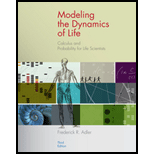
To find:The slope of secant line connecting two points of the curve of given quadratic function, and the slope tangent line as a function of x in both differential and prime notation.
Answer to Problem 13E
The slope of secant to the curve
Explanation of Solution
Given information:
The given quadratic function is
Method/Formulaused:
The slope of a line is tangent to the angle, line makes with x -axis. If
Calculations:
Let us consider two neighboring points

The line PQ is a secant line connecting points
In figure, the coordinates of point N are
Hence, the slope of secant PQ is
For the given function,
We may write
Thus, the slope of secant to the curve
The secant PQbecomes tangent when point Q coincides with point P that is when
The slope of tangent is the limit of the slope of secant as
Now, taking limit as
Thus, the slope of the tangent at point
(Differential form), or
(Prime notation)
Conclusion:
The slope of secant to the curve
Want to see more full solutions like this?
Chapter 2 Solutions
Modeling the Dynamics of Life: Calculus and Probability for Life Scientists
 Mathematics For Machine TechnologyAdvanced MathISBN:9781337798310Author:Peterson, John.Publisher:Cengage Learning,Algebra & Trigonometry with Analytic GeometryAlgebraISBN:9781133382119Author:SwokowskiPublisher:Cengage
Mathematics For Machine TechnologyAdvanced MathISBN:9781337798310Author:Peterson, John.Publisher:Cengage Learning,Algebra & Trigonometry with Analytic GeometryAlgebraISBN:9781133382119Author:SwokowskiPublisher:Cengage

